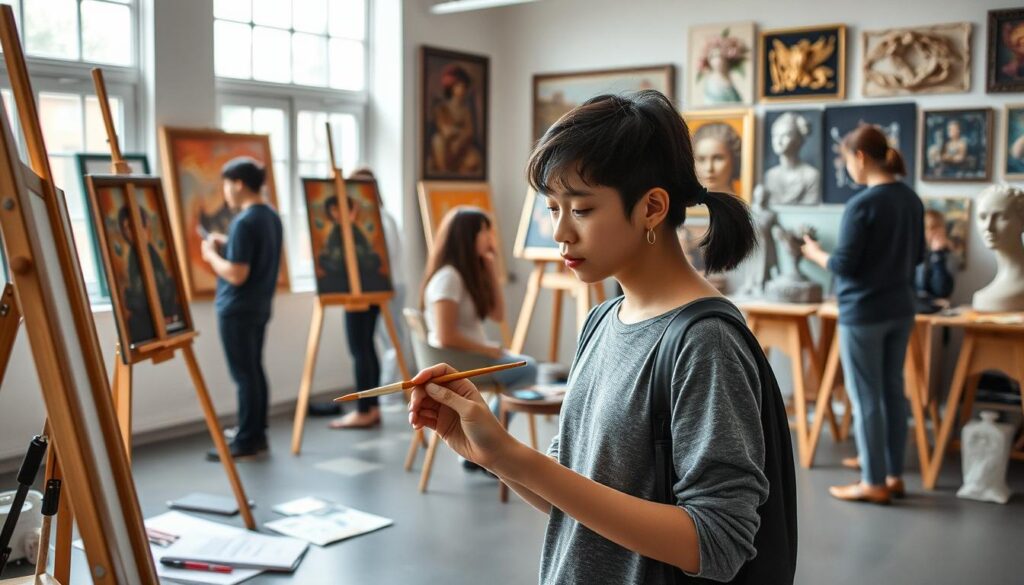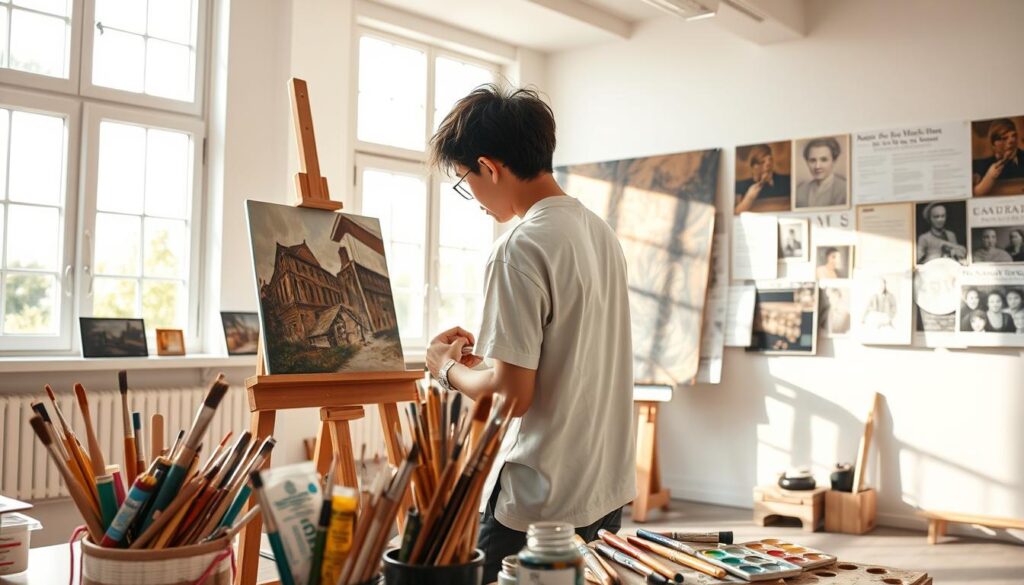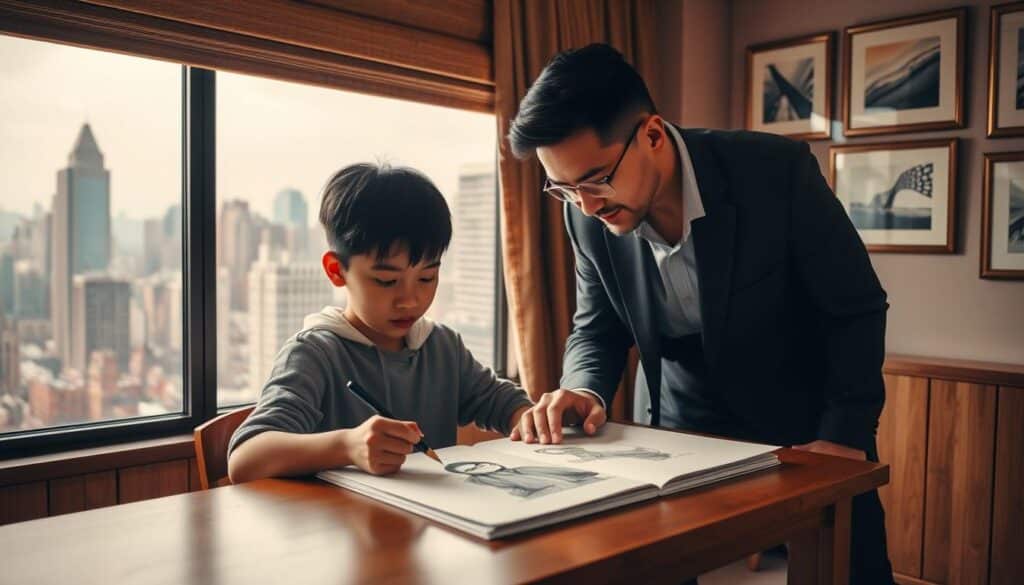Did you know that over 90% of students who take Fine Art A Level report a significant improvement in their creative and critical thinking skills? This challenging yet rewarding course is designed to push students beyond their limits, helping them develop a deep understanding of various artistic mediums and techniques. Whether you’re a student or a parent, understanding the demands and rewards of the Fine Art A Level is crucial for making informed decisions about your educational journey.
The transition from GCSE to A Level Fine Art is a significant leap. While GCSE focuses on foundational skills, A Level delves into advanced techniques, personal investigation, and the development of a professional portfolio. Students are expected to demonstrate a higher level of critical thinking and creativity, making it essential to be well-prepared. The entry requirements typically include five GCSEs, including English Language and Art/Design, along with a strong portfolio submission.
The curriculum is diverse, covering a wide range of media and creative techniques. From painting and sculpture to printmaking and digital art, students have the opportunity to explore their interests and develop their unique style. The course also emphasizes research and the study of renowned artists, helping students gain inspiration and insight into different artistic movements and styles.
For students who may struggle with the demands of the course, private tutors can provide the additional support needed to excel. Our expert tutors at getutor.com.hk offer personalized guidance, helping students master techniques, develop their portfolios, and prepare for exams. With the right support, students can overcome challenges and achieve their full potential.
Key Takeaways
- The Fine Art A Level significantly enhances creative and critical thinking skills.
- Students must meet specific entry requirements, including GCSEs and a portfolio.
- The curriculum covers various artistic mediums and techniques.
- Private tutors can provide essential support for success in the course.
Understanding the Fine Art A Level Landscape
Exploring the Fine Art A Level course offers students a dynamic journey through creative expression and academic rigor. This section delves into the structure and expectations of the course, helping students and parents navigate its demands effectively.
Course Structure and Curriculum Insights
The Fine Art A Level is divided into two main components. The personal investigation accounts for 60% of the grade, allowing students to explore a theme of their choice through extensive research and practical work. The remaining 40% comes from an externally set assignment, which challenges students to respond to a stimulus within a controlled timeframe.
Students engage with a variety of media, including painting, sculpture, and printmaking. Sketchbook practice is integral, serving as a repository of ideas and developmental work. The curriculum emphasizes both practical skills and theoretical understanding, requiring students to analyze historical and contemporary art movements.
Assessment is based on four objectives: developing ideas, using resources, recording observations, and presenting work. Students must demonstrate proficiency in these areas to excel.
Yearly Development and Expectations
In Year 1, students focus on building foundational skills and developing their portfolios. They explore different techniques and media, establishing a strong base for their creative practice. Year 2 shifts towards independent project work, culminating in the personal investigation and the externally set assignment.
Regular feedback and assessments guide students’ progress, helping them refine their skills and conceptual understanding. Parents play a crucial role by providing support and encouraging consistent effort.
Common Challenges and Pitfalls in Fine Art A Level
Embarking on the Fine Art A Level journey can be both rewarding and challenging. Students often face obstacles that can hinder their progress if not addressed early. Understanding these common pitfalls is crucial for success.
Frequent Mistakes Students Make
One of the most common mistakes is insufficient sketchbook development. Many students underestimate the importance of regular sketching, which hampers their creative growth. Additionally, misinterpreting creative briefs can lead to work that doesn’t meet the assignment’s requirements.
| Common Mistakes | Suggested Solutions |
|---|---|
| Insufficient sketchbook development | Set aside dedicated time for regular sketching to explore ideas and techniques. |
| Misinterpretation of creative briefs | Seek clarification from teachers and thoroughly plan before starting projects. |
| Underutilizing teacher feedback | Actively seek and incorporate feedback to refine work and concepts. |
| Overloading portfolios | Curate a balanced selection of works that showcase a clear artistic voice. |
Struggles with Creative and Technical Aspects
Students often struggle to balance creative expression with technical skills. While some may excel in ideas, others may find it challenging to execute them effectively. Regular feedback and persistent practice are key to overcoming these challenges, as highlighted by educational sources.
The practical assessments and the externally set assignment require a deep understanding of both creative and technical aspects. Structured guidance from experienced tutors can help students navigate these demands, ensuring they meet the course requirements and produce high-quality work.
Mastering fine art a level: Strategies and Techniques
Success in the Fine Art A Level requires a blend of skill development, creative exploration, and strategic planning. By mastering these elements, students can unlock their full potential and achieve outstanding results.
Developing Artistic Skills and Techniques
A strong foundation in artistic techniques is essential. Students should regularly practice methods like painting, collage, and printmaking. Structured practice helps build confidence and mastery. Life drawing and painting from observation are particularly valuable, as they enhance observational skills and technical precision.
Year 2 students can build on Year 1 skills by refining their personal investigation. This involves in-depth research and practical work, culminating in a cohesive portfolio. Experimental media work encourages students to explore beyond traditional methods, fostering a versatile artistic practice.
Embracing Creative Experimentation and Research
Creative experimentation is vital for developing a unique style. Students should explore various media, from traditional paints to digital tools, to discover their strengths. Research plays a key role in inspiring ideas and informing artistic decisions. Visiting galleries and studying historical movements can provide valuable insights and motivation.
A well-structured portfolio is crucial for success. Students should curate their work to showcase a clear artistic voice. Regular feedback sessions with tutors can help refine ideas and techniques, ensuring the portfolio meets the highest standards.
By combining technical skill with creative exploration, students can navigate the challenges of the Fine Art A Level. With dedication and the right strategies, they can achieve their goals and excel in this rewarding course.
Achieve Success with Expert Private Tutors
Unlock your full potential in the Fine Art A Level with personalized guidance from expert tutors. One-on-one tutoring offers tailored support to overcome challenges and excel in both creative and technical aspects of the course.
Overcoming Obstacles through Personalized Guidance
Our experienced tutors specialize in addressing individual needs, whether it’s refining techniques or enhancing your artistic vision. They provide structured feedback to help you master the curriculum and excel in your portfolio development.
| Benefits of Tutoring | Services Offered |
|---|---|
| Customized learning plans | Personalized feedback sessions |
| Technical skill development | Portfolio curation guidance |
| Creative strategy formulation | Exam preparation support |
Utilizing the Free Matching Service at getutor.com.hk
Discover how our free matching service connects you with the perfect tutor. This efficient service ensures you find expert guidance tailored to your specific needs, helping you achieve your goals in the Fine Art A Level.
By leveraging our network of expert tutors, you can access reliable and caring support designed to enhance your learning experience. Take the first step towards academic success with personalized tutoring.
Conclusion
Mastering the Fine Art A Level requires a combination of creativity, technical skill, and strategic planning. As explored throughout this guide, understanding the course structure, overcoming challenges, and seeking expert support are crucial for success. Students should actively engage in regular sketchbook practice, carefully interpret creative briefs, and utilize teacher feedback to refine their work.
The curriculum offers a diverse exploration of artistic mediums, from painting and sculpture to digital art. By embracing creative experimentation and conducting thorough research, students can develop a unique style and a cohesive portfolio. Private tutoring provides personalized guidance, helping students excel in both technical and creative aspects of the course.
We encourage parents to use our free matching service to find the ideal tutor for their child. With the right support, students can overcome challenges and achieve their full potential in the Fine Art A Level. Ensure your child’s success by taking the first step towards personalized tutoring today.
FAQ
What is the structure of the Fine Art A Level course?
The Fine Art A Level course is divided into two years. The first year focuses on developing foundational skills in painting, sculpture, and printmaking. The second year emphasizes personal investigation and the creation of a portfolio. Students also participate in an externally set assignment.
How important is a portfolio in Fine Art A Level?
A portfolio is crucial. It showcases a student’s ability to explore ideas, use different materials, and develop a personal theme. We encourage students to start building their portfolio early to demonstrate their progress and creativity.
What skills are essential for success in Fine Art A Level?
Key skills include strong observational abilities, creativity, and technical proficiency in various media. Students should also develop research skills and the ability to critically analyze their work and the work of other artists.
How does Fine Art A Level differ from GCSE Art?
Fine Art A Level is more advanced, requiring students to independently manage their time and explore complex themes. It also places greater emphasis on personal investigation and the development of a cohesive body of work.
What opportunities are available after completing Fine Art A Level?
Students can pursue art-related degrees, foundation courses, or apprenticeships. The skills gained, such as creativity and problem-solving, are also valuable in many other fields.
How can I prepare for the externally set assignment?
Start by practicing a range of techniques and materials. Regularly visit galleries and study the work of other artists to broaden your understanding of different styles and themes.
What role does research play in Fine Art A Level?
Research is a cornerstone of the course. It helps students develop their ideas, understand historical contexts, and inspire their creative work. We recommend dedicating time each week to explore and document your findings.
How can I improve my painting and sculpture skills?
Regular practice is essential. Experiment with different materials and techniques to find what works best for you. Seeking feedback from teachers or mentors can also help refine your skills.
What is a personal investigation in Fine Art A Level?
A personal investigation is an in-depth study of a theme or idea. It allows students to explore a subject they are passionate about, combining research, practical work, and written analysis into a cohesive project.
How can I stay organized throughout the course?
Create a timeline and set regular goals. Use a sketchbook to document your progress and ideas. Regularly review your work with your teacher to ensure you are on track.
What support is available for students struggling with the course?
We offer personalized tutoring and study groups. Our experienced teachers are always available to provide guidance and help students overcome challenges.






